The throat or pharynx is located behind the nose and the mouth and is connected to both of them. It is a muscular tube that carries both food and air. As it goes down, it splits in two passages the esophagus and the larynx.
The esophagus is the tube that goes from the throat to the stomach. It carries food and drink.
The larynx carries air. The larynx also contains the vocal cords which produce sound, allowing us to speak. Air passes through the larynx into the trachea and then into the lungs.
The tonsils are located on both sides of the back of the mouth in the throat and the uvula is a small flap of tissue visible in the back of the throat between the tonsils. It varies in length. As part of the soft palate, the uvula helps prevent food and fluids from entering the nasal cavity during swallowing and assists in the formation of certain sounds during speech. A long uvula may cause snoring and occasionally contributes to obstructive sleep apnea.
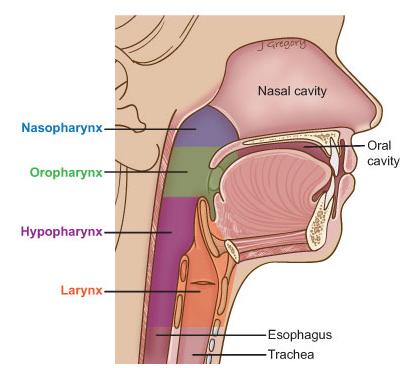
Conditions We Treat
I-Sore throat or throat infection
Sore throat is pain in the throat and one of the throat infection symptoms. The pain can be severe and is usually worsened by swallowing. Many people with throat pain refuse to eat or drink. The most common reason for sore throat is infection, as
1-Tonsillities

Tonsils are two small glands located in the back of throat. Tonsils house white blood cells to help to fight infection. When the tonsils become infected, the condition is called tonsillitis.
Tonsillitis can occur at any age and is a common childhood infection. Tonsillitis Symptoms include a sore throat, swollen tonsils, and fever. This condition is contagious and can be caused by a variety of common viruses or bacteria, such as streptococcal bacteria, which causes strep throat. Tonsillitis caused by strep throat can lead to serious complications if left untreated.
How tonsillitis is diagnosed, what are tonsillitis symptoms?
Diagnosis of acute tonsillitis is based on a physical examination of throat. The doctor may be taking a throat culture by gently swabbing the back of throat. The culture will be sent to a laboratory to identify the cause of throat infection.
Tonsillitis treatment (tonsillitis cure)
 A mild case of tonsil infection does not necessarily require treatment, especially if it is viral, such as a cold. Pain medicines to relieve the sore throat can help while the throat is healing. Antibiotics will be prescribed to fight a bacterial infection. It’s important to complete the full course of antibiotics. If a person becomes dehydrated due to tonsillitis and swallowing difficulties he may need intravenous fluids.
A mild case of tonsil infection does not necessarily require treatment, especially if it is viral, such as a cold. Pain medicines to relieve the sore throat can help while the throat is healing. Antibiotics will be prescribed to fight a bacterial infection. It’s important to complete the full course of antibiotics. If a person becomes dehydrated due to tonsillitis and swallowing difficulties he may need intravenous fluids.
Home care tips to ease throat pain or tonsillitis remedy at home
LWhen you have throat pain or other throat infection symptoms:
- drink plenty of fluids
- get lots of rest
- gargle with warm salt water several times a day
- use throat lozenges
- use a humidifier to moisten the air in the home
- avoid smoke
Who Needs Tonsillectomy (tonsils surgery or tonsil removal)?
One case of tonsillitis is not enough to warrant a tonsillectomy. Usually, the surgery is a treatment option for those who are often sick with tonsillitis or strep throat. Tonsillectomy is indicated when there is
- breathing problems related to large tonsils
- recurrent tonsillitis or strep throat
- frequent and loud snoring due to big tonslis
- periods in which breathing stops during sleep, or sleep apnea due to enlarged tonsils
- bleeding of the tonsils
- trouble swallowing chewy foods, especially meats due to big tonsils
- cancer of the tonsils
2- Laryngitis
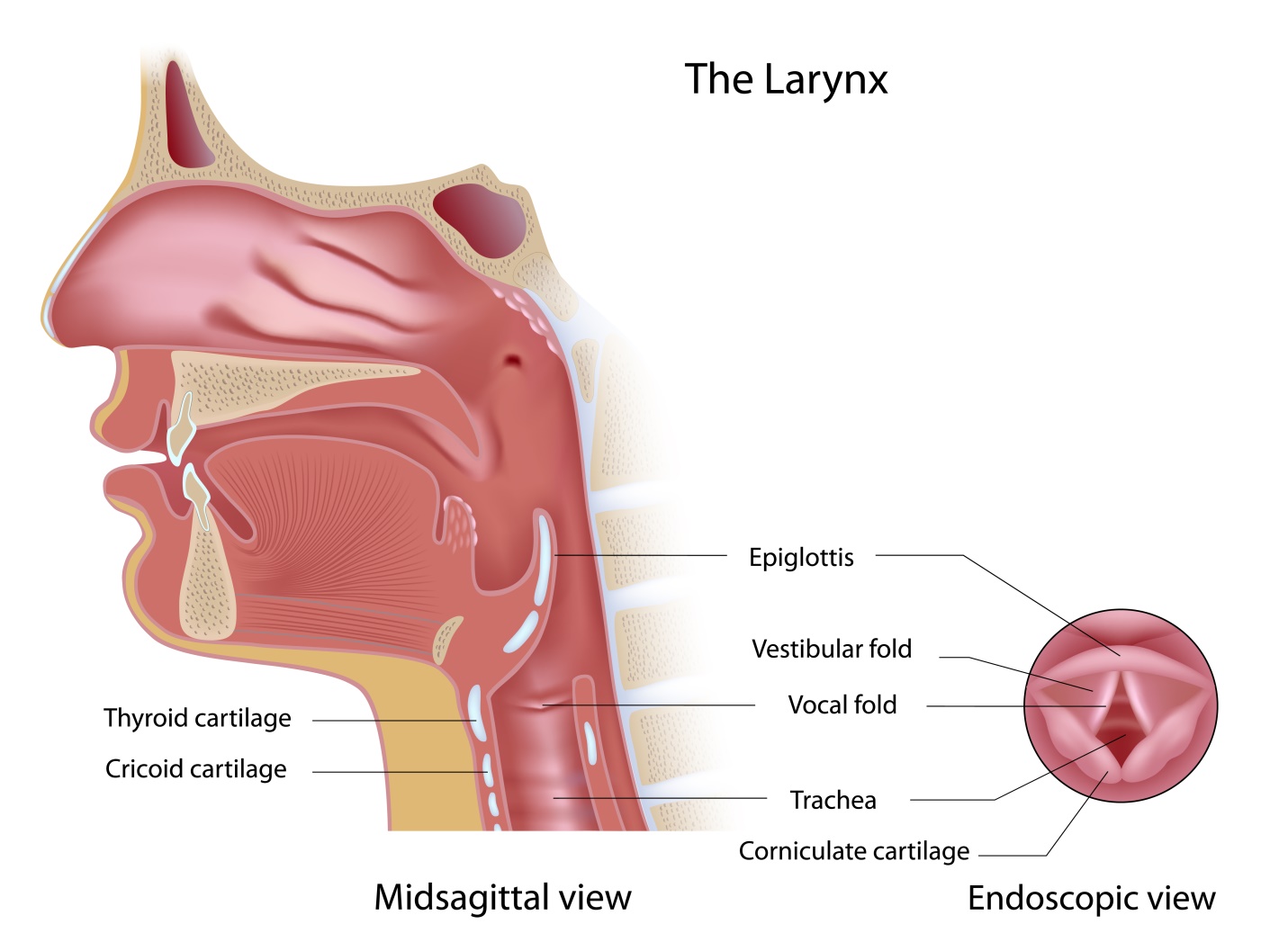
Laryngitis is inflammation (swelling) of your larynx and is usually caused by a virus.
The symptoms are hoarseness or losing the voice, cough, throat clearing, fever and sore throat
How is laryngitis diagnosed?
Diagnosis can be done during physical examination of the throat and larynx with a mirror or with tube-like scope (rigid or flexible laryngoscopy)
Laryngitis treatment
- Voice rest by not talking much or at all
- cough medication
- Drink lots of water and other fluids
- Steam inhalations
- Stop smoking, if you smoke
II-vocal cord nodules, polyps, and granulomas
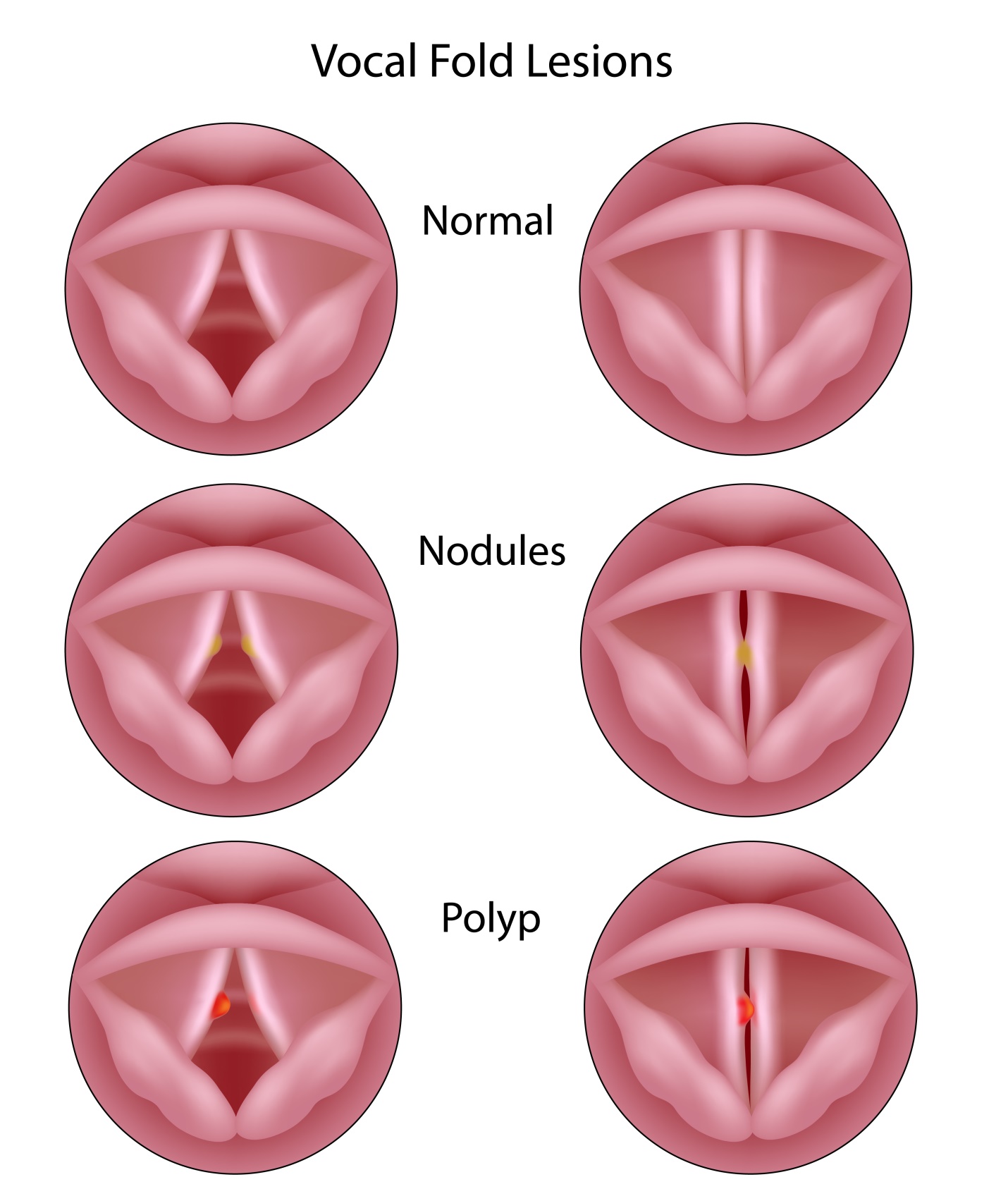
Benign growths that cause hoarseness and a breathy voice
Vocal cord polyps are often the result of an acute injury (such as from shouting at a football game) and typically occur on only one vocal cord. Polyps may have several other causes, including gastroesophageal reflux, or chronic inhalation of irritants (such as industrial fumes or cigarette smoke). Polyps tend to be larger and bulge out more than nodules. Polyps are common among adults.
Vocal cord nodules occur on both vocal cords and result mainly from chronic abuse of the voice (habitual yelling, singing, or shouting or using an unnaturally low frequency). Nodules can occur in children.
Vocal cord granulomas are often the result of vocal cord injury due to uncontrolled gastroesophageal reflux (GERD) or damage during endotracheal intubation (insertion of a plastic breathing tube through the mouth into the trachea. Granulomas are common among adults.
How are they diagnosed?
During physical examination of the vocal cords with a mirror or with tube-like scope (rigid or flexible laryngoscopy)
Sometimes biopsy is advisable with direct laryngoscopy under general anesthesia to rule out malignant tumors of the larynx
Treatment
Treatment relies on avoiding whatever is irritating vocal cords and voice rest. If abuse of the voice is the cause, voice therapy conducted by a speech therapist may be needed to teach the person how to speak or sing without straining the vocal cords.
Most nodules and granulomas go away with this treatment. Granulomas that do not go away can be removed surgically
III-Neck Lump
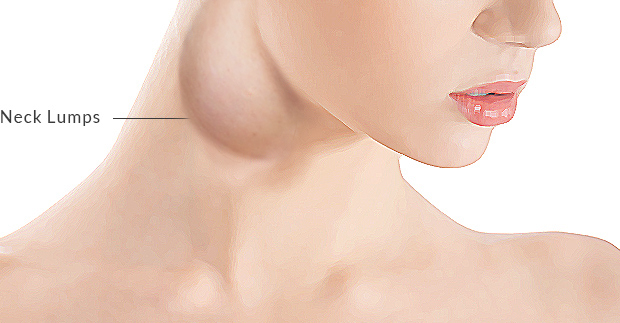
Abnormal swelling or lump in the neck may be discovered by a patient or by a doctor during an examination. Neck lumps may be painful or painless depending on what has caused them. Painless neck lumps may be present for a long time before people notice them. Most neck lumps are enlarged lymph nodes, however it may be congenital cyst or an enlarged salivary gland or an enlarged thyroid gland.
Enlarged lymph nodes
Lymph node contains cells that help your body fight off infection, bacteria or viruses and get rid of tumor cells. The most common cause for lymph nodes to become enlarged is infection. A much less common but more serious cause of enlarged lymph nodes is Cancer
What are warning signs?
It is advised to visit the clinic if you feel
- A lump in the neck that lasts more than two weeks
- Any hoarseness or other voice changes lasting more than two weeks
- An ulcer or swelling in mouth especially if accompanied by lumps in neck
- Pain almost every time you try to swallow something,
- Persistent pain in the ear when you swallow
What is the doctor is going to do for diagnosis?
The diagnosis is based on physical examination during which pencil size flexible scope with camera will be introduced to the throat and larynx. Ultrasound for neck, CT scan, MRI and Ultrasound Guided Fine Needle Aspiration and cytology may be requested.
VI-Salivary Gland Disorders
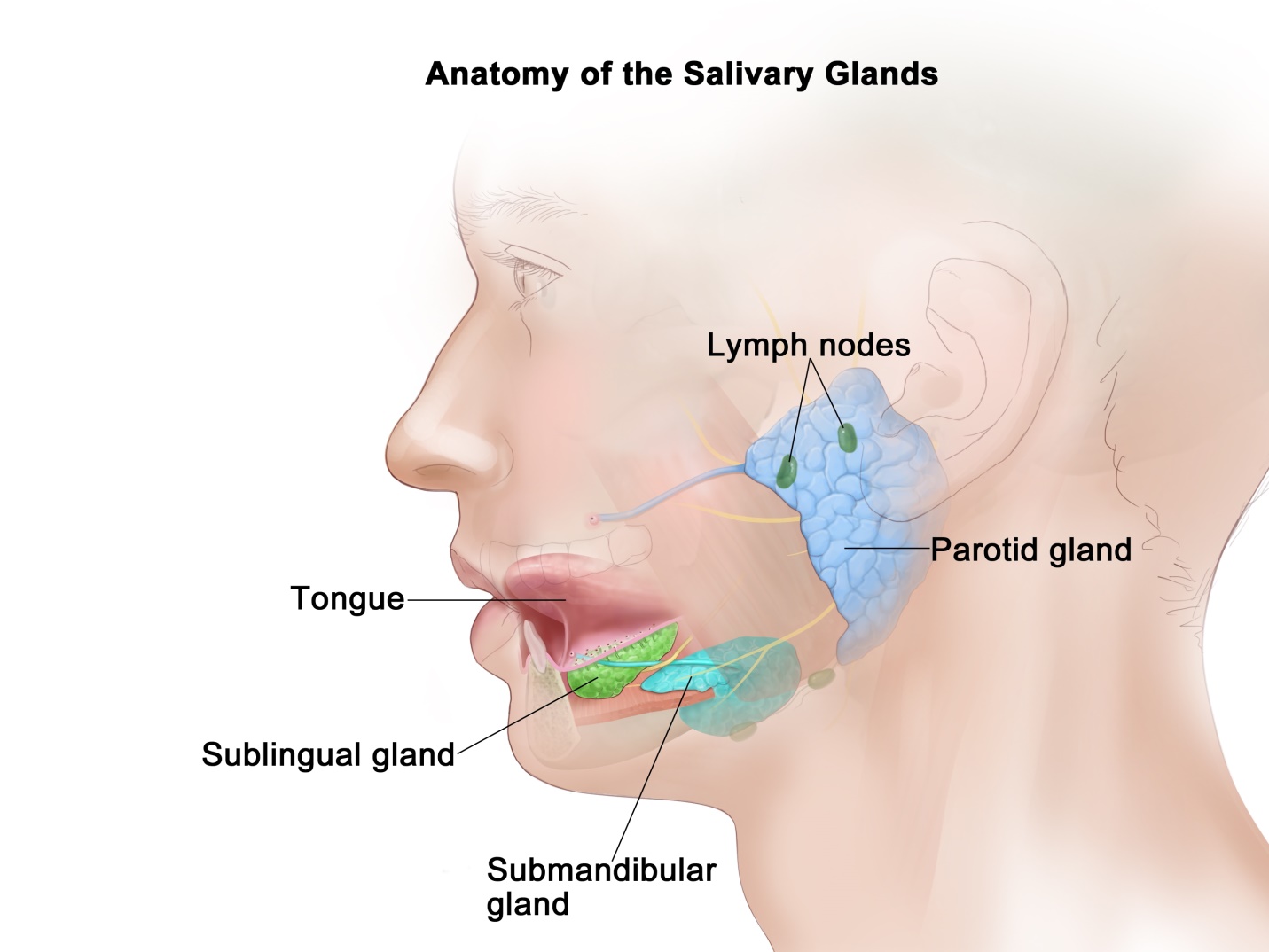
There are three major pairs of salivary glands in the mouth:
- The parotid glands, the largest pair of salivary glands, lie just behind the angle of the jaw, below and in front of the ears.
- The sublingual glands and the submandibular glands, the two smaller pairs, lie deep in the floor of the mouth.
In addition to these major glands, many tiny salivary glands are distributed throughout the mouth. All of the glands produce saliva, which aids in breaking down food as part of the digestive process. Several types of disorders affect the salivary glands such as stones, infection, and swelling.
Salivary gland stones
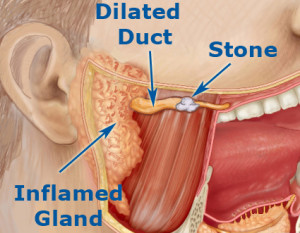
A stone can form from salts contained in the saliva. Salivary stones create problems when they block the tube (duct) that carries saliva from the gland to the mouth. Blockage makes saliva back up inside the duct, causing the salivary gland to swell painfully. The pain and swelling worsen after eating because saliva production will be increased, the duct is blocked, the saliva has no place to go and the gland swells. The swelling may go down after a few hours. A blocked duct and gland filled with stagnant saliva may become infected with bacteria.
Salivary gland infection
Most salivary gland infections occur in people who have something that blocks the flow of saliva (such as a stone) or who have very low flow of saliva. Infection is most common in the parotid gland .Sometimes a collection of pus (abscess) forms in the gland, and a small amount of pus comes out of the duct of the gland. The infected gland is swollen and very painful.
Salivary gland swelling
Swelling will be due to infections or stones or also can result from cancerous (malignant) or noncancerous (benign) tumors in the salivary glands.
How is salivary Gland Diseases Treated?
Treatment of salivary gland diseases falls into two categories: medical and surgical.
Treatments and procedures
Flexible laryngoscopy
It is a commonly performed procedure in the otolaryngologist’s office and serves as an objective diagnostic tool in the evaluation of nose, nasopharynx, pharynx, larynx and vocal cords. The test takes about 5 to 10 minutes. Medicine will be put inside your nose and in your mouth to numb the area, after that the endoscope will be inserted into your throat. This is a long flexible tube with a camera at the end; Pictures may be projected onto a screen.
Laryngoscopy may be accomplished with either a flexible fiberoptic endoscope from the nose or with a rigid laryngoscope form the mouth. When performed by experienced practitioners, both flexible endoscopy and rigid endoscopy are usually well tolerated.
Tonsillectomy (tonsils surgery or tonsils removal)
Tonsillectomy or tonsils surgery is a surgical procedure to remove the tonsils. There are several different ways for tonsils removal. No matter what surgical method doctor chooses, it is done under general anesthetic and takes 45-minutes to 1 hour. The patient won’t be aware of the surgery or won’t feel any pain. When he wakes up after the tonsil surgery, he’ll be in a recovery room. Medical staff will be monitoring his blood pressure and heart. He will usually need to stay in hospital for only one night.
Post-Operative Instructions: Adenotonsillectomy, Tonsillectomy, Adenoidectomy
- 2-3 days after a tonsillectomy you will note an increase in pain in the throat. This is the inflammation settling and the scabs starting to form. The scabs will be white, yellow or green coating where tonsils once were. This is not a sign of infection. Foul breath is normal while scabs are present. The scabbing color can change throughout recovery. It is not normal to have coating on the tongue.
- 2-3 days after an adenoidectomy you may have increase in nasal congestion. This is caused by the inflammation settling in and is normal recovery .You may have some blood tinged mucus from the nose . This should not be like a nosebleed, and should only appear in small amounts mixed in with the mucus. A sore or stiff neck is also common after an Adenoidectomy
- Approximately one week after a tonsillectomy you will have a major increase in throat pain. At this point the scabs are starting to come off. A little bit of bleeding or oozing is okay at this point. If these are noted you can drink cold items .If bleeding persists proceed to ER immediately
- Ear Pain is very normal after a tonsillectomy and can be present throughout the whole recovery process
- No lifting, bending, straining for two weeks following the surgery. do not travel for two weeks following surgery .or until seen post operatively
- Staying hydrated after Tonsillectomy is very important. Even if the patient isn’t eating much at all .as long as they are hydrated this is okay. Signs of dehydration are uncontrollable pain, high temperature headache and nausea and vomiting and lethargic behavior .If you suspect dehydration go to ER at once for IV Fluid replacement.
- Diet after a Tonsillectomy: Soft foods are recommended. Avoid acid items as they may burn when swallowing. Popsicles, gelatin juices not acidic, water, soft drinks are good. Avoid milk/dairy products for at least a few days following surgery as they may increase phlegm production. Salty foods such as soups, broths may help relieve discomfort and promote healing

